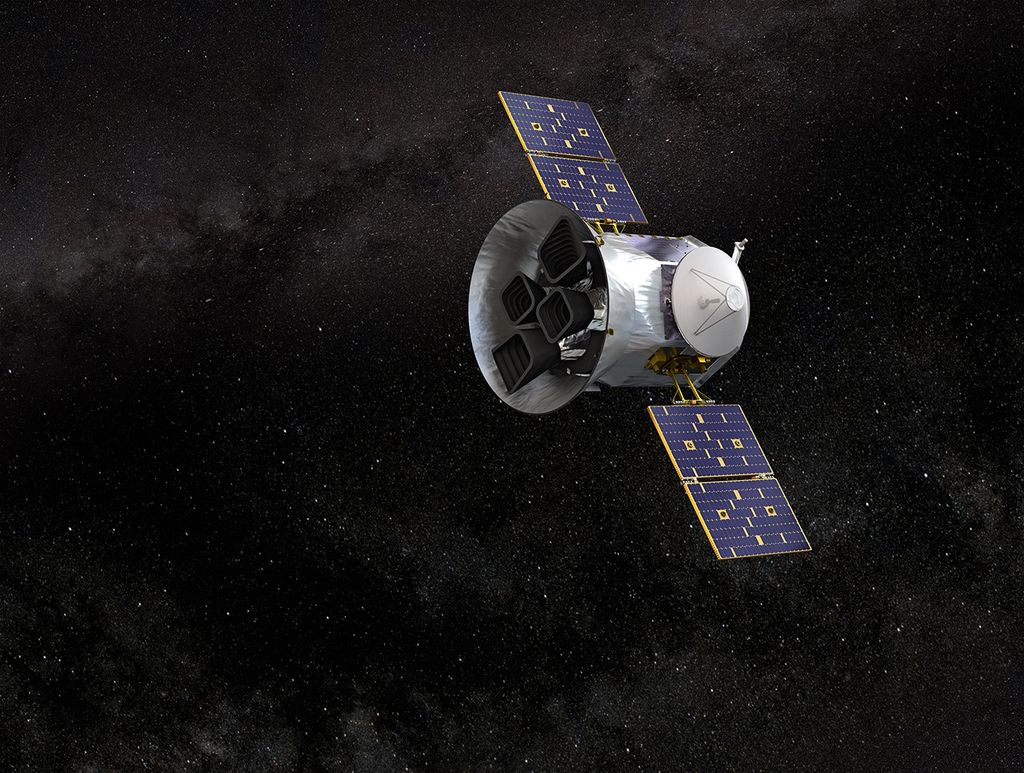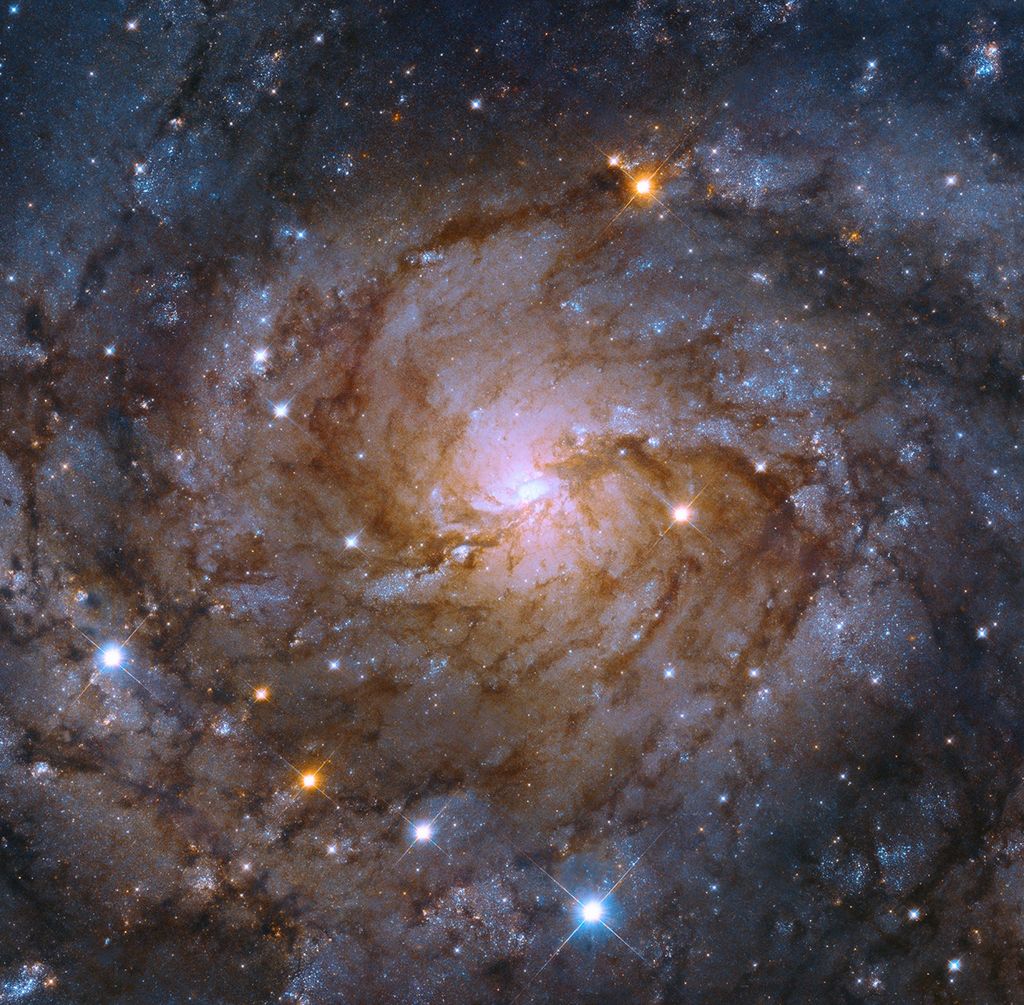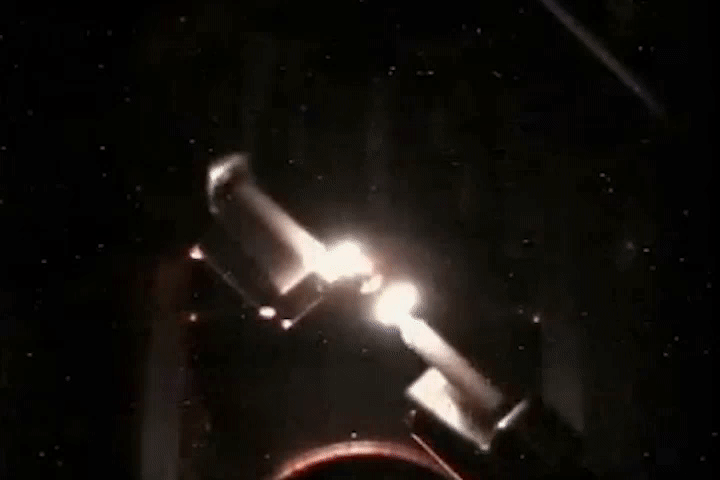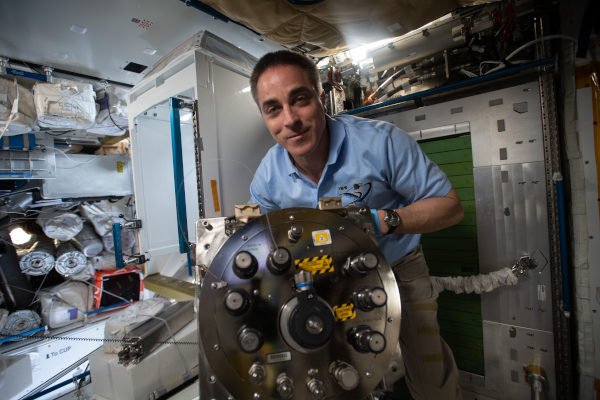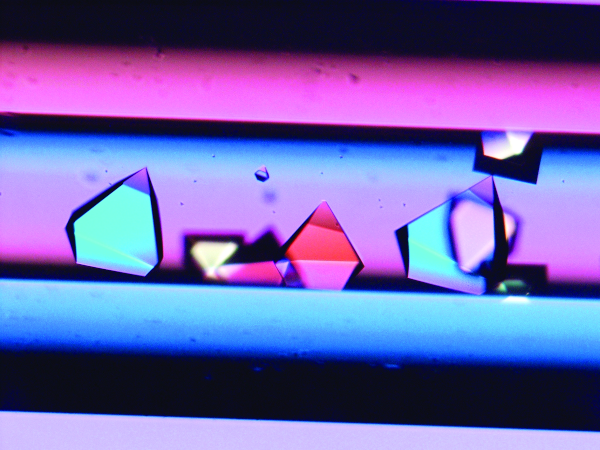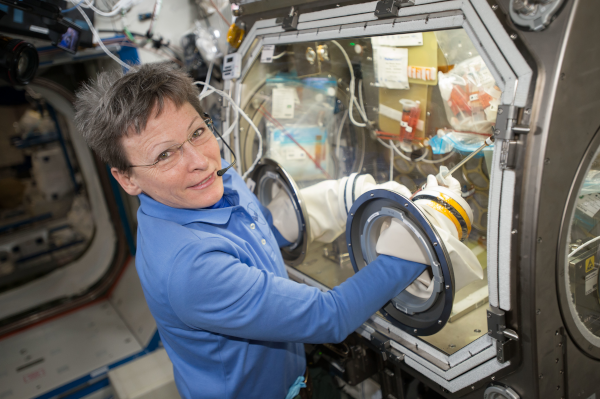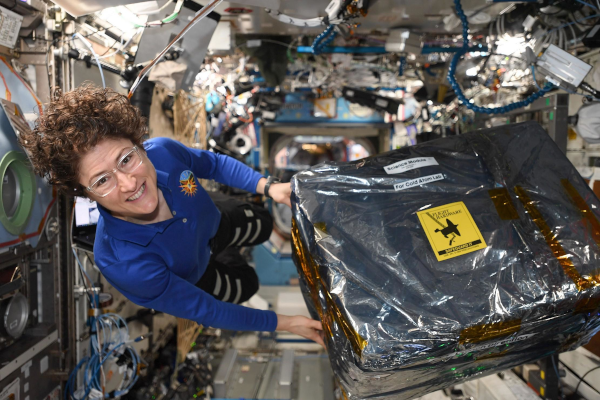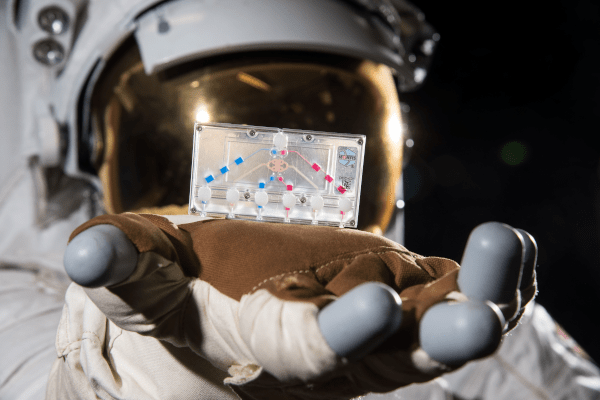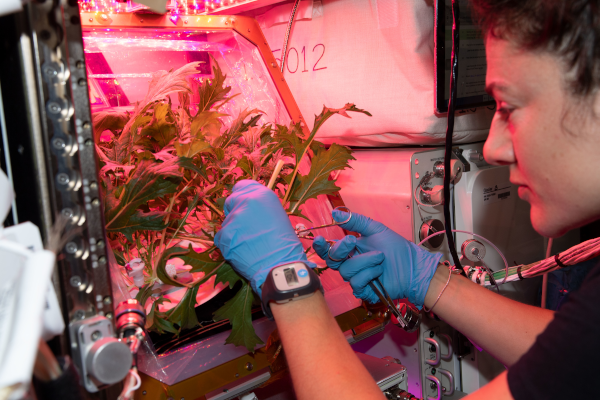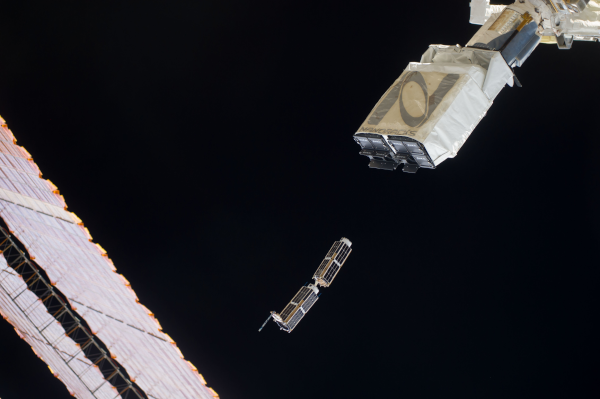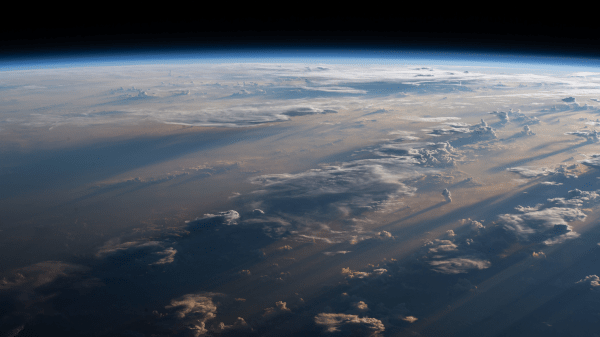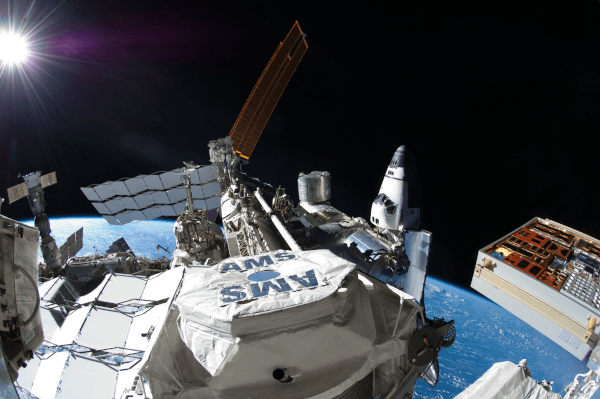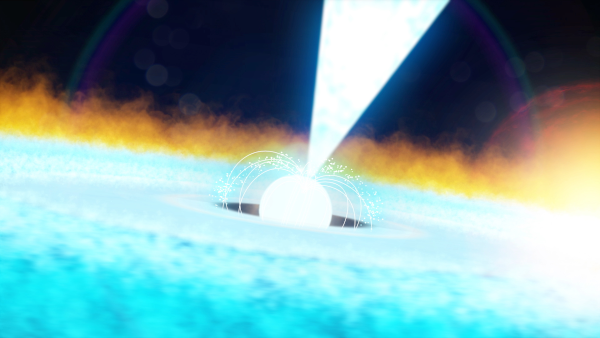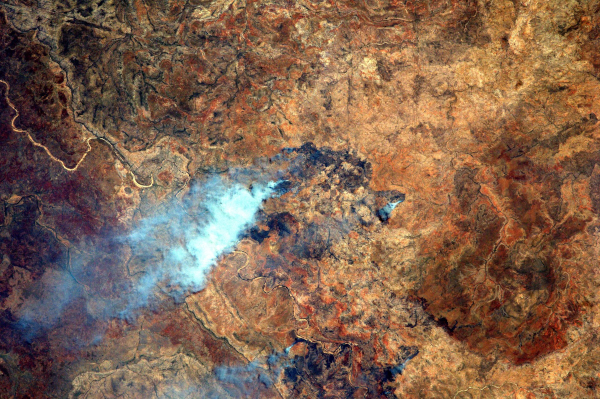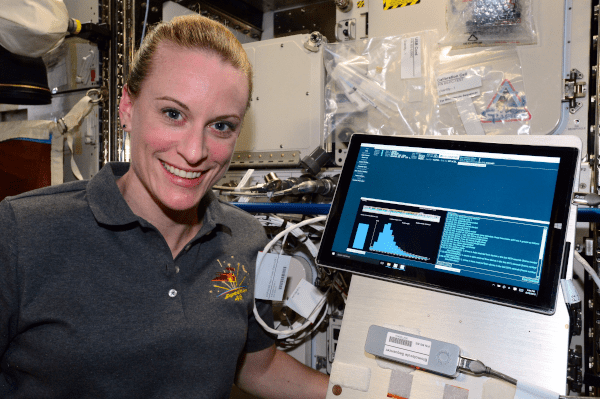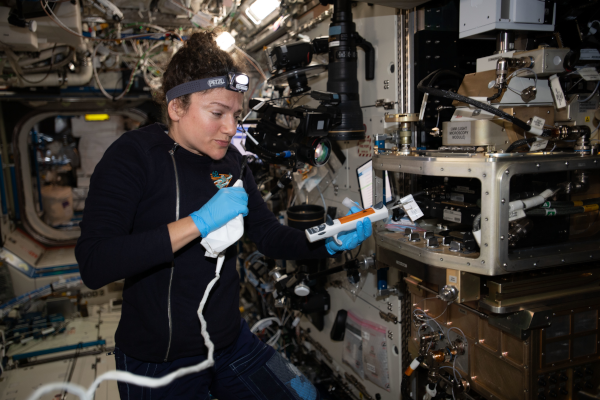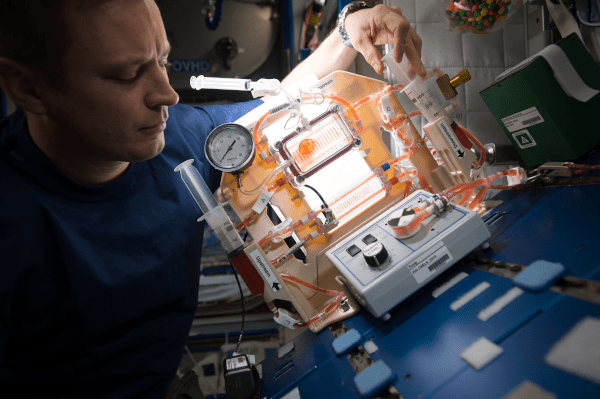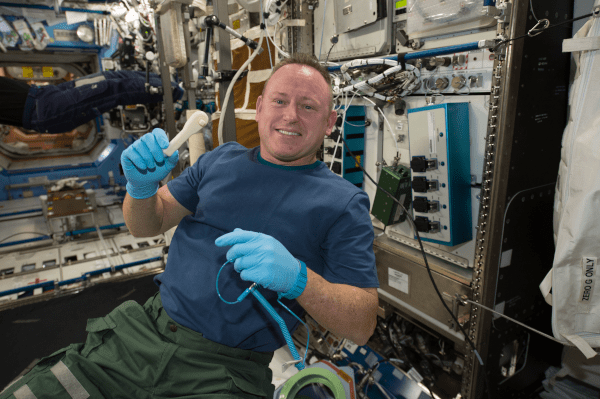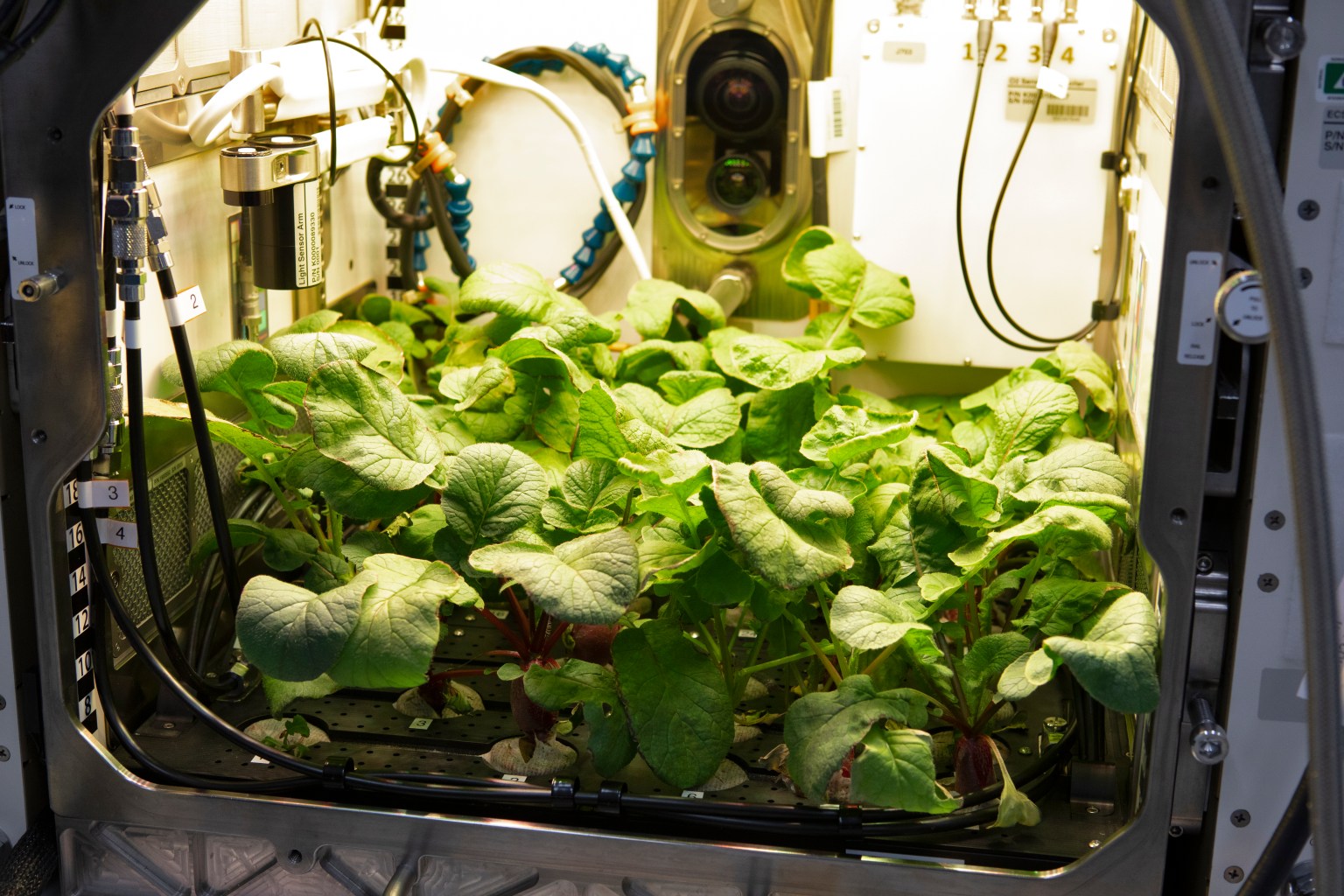Dive into 25 years of research aboard the space station here.
For 20 years, the astronauts aboard the International Space Station have conducted science in a way that cannot be done anywhere else. Orbiting about 250 miles above our planet, the space station is the only laboratory available for long-duration microgravity research.
During the past two decades, the space station has supported numerous discoveries, scientific publications, unique opportunities, and historic breakthroughs. This research not only helps us explore farther into space, it also benefits us back on Earth.
To mark 20 years of science, take a look at 20 scientific and technological breakthroughs we have achieved as a result of space station science.
Click on each breakthrough in the list below to learn more about it, why we conducted the research in microgravity, and why it matters.
20 Breakthroughs from 20 Years
Fundamental disease research: Alzheimer’s Disease. Parkinson’s Disease. Cancer. Asthma. Heart Disease. If any of these conditions has affected your life, so has space station research.
Discovery of steadily burning cool flames: When scientists burned fuel droplets in the Flame Extinguishing Experiment (FLEX) study, something unexpected occurred. A heptane fuel droplet appeared to extinguish, but actually continued to burn without a visible flame at temperatures two-and-a-half times cooler than a typical candle.
New water purification systems: Water is vital for human survival. Unfortunately, many people around the world lack access to clean water. At-risk areas can gain access to advanced filtration and purification systems through technology that was developed for the space station, enabling the astronauts living aboard to recycle 93% of their water.
Drug development using protein crystals: Protein crystal growth experiments conducted aboard the space station have provided insights into numerous disease treatments, from cancer to gum disease to Duchenne Muscular Dystrophy.
Methods to combat muscle atrophy and bone loss: Space studies have contributed greatly to our knowledge of bone and muscle loss in astronauts – and how to mitigate those effects. The knowledge gained also applies to people on Earth dealing with diseases such as osteoporosis.
Exploring the fifth state of matter: 25 years ago, scientists first produced a fifth state of matter, called a Bose-Einstein condensate (BEC), on Earth. In 2018, NASA’s Cold Atom Lab became the first facility to produce that state of matter in space. This achievement may provide insight into fundamental laws of quantum mechanics.
Understanding how our bodies change in microgravity: When humans head to Mars, we need to know what challenges we face. Long-term stays aboard the space station have uncovered unexpected ways that the human body changes in microgravity.
Testing tissue chips in space: Tissue chips are roughly thumb-drive-sized devices that contain human cells in a 3D matrix, representing functions of an organ. Chips have been sent to station, seeking to better understand the impact of microgravity on human health and to translate that understanding to improved health on Earth.
Stimulating the low-Earth orbit economy: From satellite deployment to in-space research, a vibrant commercial space economy has developed, with a value that now exceeds $345 billion. The space station has been a key part of supporting that growth.
Growing food in microgravity: The ability to grow supplemental food can help humans explore farther from Earth. Many techniques for growing plants have been explored aboard the space station to prepare for these missions. On August 10, 2015, astronauts sampled their first space-grown salad, and astronauts now are growing radishes in space.
Deployment of CubeSats from station: CubeSats are one of the smallest types of satellites and provide a cheaper way to perform science and technology demonstrations in space. More than 250 CubeSats have now been deployed from the space station, jumpstarting research and satellite companies.
Monitoring our planet from a unique perspective: The capacity to host varying complements of instruments, both internal and external, has evolved the station into a robust platform for researchers studying Earth’s water, air, land masses, vegetation, and more while providing them additional views beyond those of NASA’s typical Earth remote-sensing satellites.
Collecting data on more than 100 billion cosmic particles: The Alpha Magnetic Spectrometer – 02 has provided researchers around the globe with data that can help determine what the universe is made of and how it began.
A better understanding of pulsars and black holes: Two tools installed on the outside of the space station, NICER and MAXI, have worked in tandem to advance our knowledge of pulsars and black holes.
Student access to an orbiting laboratory: Companies and professors are not the only ones using the space station for microgravity research. Station has given elementary- to college-aged students access to science in space and the opportunity to study microgravity’s effects.
Capability to identify unknown microbes in space: Having the ability to identify microbes in real time in space without the need to send them back to Earth for identification would be revolutionary for the world of microbiology and space exploration. The Genes in Space-3 team turned that possibility into reality in 2017.
Opening up the field of colloid research: Toothpaste, 3D printing, pharmaceuticals, and detecting shifting sands on Mars may not seem related to each other at all, yet each stands to benefit from improvements made thanks to research on colloids aboard the space station.
The evolution of fluid physics research: Fluids cover our planet, but sending them to space can help us better understand how they flow. The study of fluids in space has progressed from fundamental research into the testing of technology applications ranging from advanced medical devices to heat transfer systems.
3D printing in microgravity: The first item was 3D printed on the space station in 2014. Since then, we have explored 3D printing using recycled materials and even printing human tissue.
Responding to natural disasters: With crew handheld camera imagery as a core component, the station has become an active participant in orbital data collection to support disaster response activities both within the U.S. and abroad.
Explore all of these breakthroughs in more detail below
Fundamental disease research
Alzheimer’s Disease. Parkinson’s Disease. Cancer. Asthma. Heart Disease. If any of these conditions have impacted your life, space station research has also affected you. Microgravity research has provided new insights to scientists studying these diseases. Without the interference of Earth’s gravity, Alzheimer’s researchers have studied protein clusters that can cause neurodegenerative diseases. Cancer researchers studied the growth of endothelial cells on the space station. Endothelial cells help supply blood in the body, and tumors need that blood to form. Space station-grown cells grow better than those on Earth and can help test new cancer treatments.
Why do this in space? Studying cells, organoids, and protein clusters without the influence of gravity – or even the forces of container walls – can help researchers get a clearer understanding of their properties, behaviors, and responses to treatments.
Why does it matter? The space station is a tool that provides new perspectives to the fight against diseases affecting millions of people that we have been working to combat for generations.
Example experiments: Angiex Cancer Therapy, Ring Sheared Drop, Airway Monitoring, CCISS
Learn more:
Space Station Cell Study Seeks Causes of Major Diseases
NASA, Industry Partner for Space-based Study of Potential Alzheimer’s Key
Understanding Asthma from Space
Vascular Studies in Space: Good for Everyone’s Heart
Back to Full List
Discovery of steadily burning cool flames
When we think about fire, we typically think about heat, but special flames created aboard the space station keep things a bit cooler.
When scientists burned fuel droplets in the Flame Extinguishing Experiment (FLEX) study, something unexpected occurred. A fuel droplet appeared to extinguish but actually continued to burn without a visible flame. The fire went out twice—once with and once without a visible flame. This is the first time scientists observed large droplets of heptane fuel that had dual modes of combustion and extinction. The second stage was sustained by what is known as cool flame chemical heat release.
Why do this in space? Removing gravity from studies of combustion allows for exploration of the basic principles of flames. Cool flames have been produced on Earth, but they quickly flicker out. On station, cool flames can burn for minutes, giving scientists a better opportunity to study them.
Why does it matter? Typical flames produce soot, carbon dioxide, and water. Cool flames produce carbon monoxide and formaldehyde. Learning more about the behavior of these chemically different flames could lead to the development of more efficient, less-polluting vehicles.
Example experiments: FLEX, FLEX-2, Cool Flames Investigation
Learn more:
ScienceCasts: Strange Flames on the International Space Station
An Old Theory Goes up in Cool Flames
Cool flame research aboard space station may lead to a cleaner environment on Earth
Back to Full List
New water purification systems
The space station’s life support system was developed to provide the crew with clean air and water. The Water Recovery System purifies and filters the station’s water, recovering and recycling 93% of the water astronauts use in space. This technology has been licensed to adapt it into an Earth-based water treatment system. The first of many ground-based water filtration systems using NASA technology was installed in Iraq in 2006. Station research studies like AquaMembrane have also tested out other innovative water systems.
Why do this in space? Efficiently recycling wastewater aboard the space station reduces the need to provide water through resupply missions. As we travel deeper into space, resupply would be unachievable, making these systems a necessity. The restrictions imposed by the requirements of space prompted innovation that was applied to Earth.
Why does it matter? Water is vital for human survival. Unfortunately, many people around the world lack access to clean water. At-risk areas can gain access to advanced filtration and purification systems through technology developed for the space station, making a lifesaving difference in these communities.
Example experiments: AquaMembrane, Capillary Structures, JEM Water Recovery System
Learn more:
Life Support Upgrades Arrive at Station, Improve Reliability for Moon, Mars Missions
More Efficient, Lightweight Water Filtration Technologies in Space and on Earth
Advanced NASA Technology Supports Water Purification Efforts Worldwide
Back to Full List
Drug development using protein crystals
Humans contain more than 100,000 types of proteins. Each protein provides information related to our health. Studying these proteins by crystallizing them helps us learn more about our bodies and potential disease treatments. Protein crystal growth experiments conducted aboard the space station have provided insights into numerous diseases, from cancer to gum disease.
One of the most promising results of these station experiments has come from the study of a protein associated with Duchenne Muscular Dystrophy (DMD), an incurable genetic disorder. A treatment for DMD based on this research is in clinical trials.
Another investigation, PCG-5, sought to grow the therapeutic antibody Keytruda® in a more uniform crystalline form. The goal was to improve the drug such that it can be delivered by injection as opposed to IV treatment.
Why do this in space? Protein crystals grown on Earth are affected by gravity, which may alter the way the molecules align on the crystal. Researchers have discovered that growing crystals aboard the space station allows for slower growth and higher quality crystals. This high-quality crystallization allows us to identify the structures of disease-causing proteins to develop a new medications and effective treatments.
Why does it matter? The space station is a tool that could be key in the fight against diseases the medical community has been working to combat for generations. DMD alone affects 1 in 3,600 young boys.
Example experiments: JAXA PCG, PCG-5
Learn more:
ISS Benefits for Humanity: Hope Crystalizes
Getting to the Bottom of Humans’ Greatest Infection: Periodontal Disease
Improving Treatments with Tiny Crystals
Finding the Keys in Space to Treat Diseases on Earth
Back to Full List
Methods to combat muscle atrophy and bone loss
The effect of microgravity on bones and muscles provides unique opportunities for research. Space studies have contributed greatly to our understanding of bone and muscle loss in astronauts, and in people on Earth. Scientists have developed an exercise routine and diet regimen that significantly reduce the bone and muscle loss astronauts otherwise would experience during their stays on station. These findings inform the physical activity and nutrition required on deep space missions.
OsteoOmics investigated mechanisms behind bone formation and loss. Rodent Research-19 (RR-19) analyzed drugs that target myostatin, which influences the breakdown of muscles and bones. Researchers have even tested tiny chips for delivering drugs to combat muscle loss.
Why do this in space? Our bodies evolved within the constant pull of Earth’s gravity. In microgravity, bones and muscles do not have to support the body’s mass. This can cause bone and muscle loss without proper exercise. This response to microgravity provides an opportunity for better understanding these changes.
Why does it matter? Understanding how to mitigate the effects of microgravity on bones and muscles is important for future exploration in the partial gravity environments of the Moon and Mars. On Earth, bone and muscle atrophy occurs from normal aging, sedentary lifestyles, and illnesses. This condition may cause serious health issues from injuries due to falls or osteoporosis. Studying these losses in microgravity can help us better understand them and potentially create treatments for people back on Earth.
Example experiments: RR-3, RR-6, RR-19, OsteoOmics, Medaka Osteoclast
Learn more:
Rodents and a rocket carried these researchers’ dreams to space
Implantable Device That Helped Grow Muscles of Mice in Space Could Change Lives on Earth
Bone and Muscle Loss in Microgravity
Fishing For Answers on Bone Loss in Space
Preventing Bone Loss in Spaceflight with Prophylactic use of Bisphosphonate
Back to Full List
Exploring the 5th-state of matter
25 years ago, scientists on Earth first produced a fifth state of matter with properties totally unlike solids, liquids, gases, and plasmas. The achievement garnered a Nobel Prize for those scientists and changed the field of physics.
In 2018, NASA’s Cold Atom Lab became the first facility to produce that fifth state of matter, called a Bose-Einstein condensate (BEC), in Earth’s orbit. The Cold Atom Lab lowers atoms to ultracold temperatures in order to study their properties in ways not possible on Earth.
Why do this in space? Chilling atoms is the only way to produce a BEC. Ultracold atom facilities in space should be able to reach colder temperatures than labs on Earth. Additionally, scientists produce BECs in a vacuum, so on Earth the atoms are pulled down by gravity and fall quickly toward the floor. This movement typically limits observation times to less than a second without the help of magnetic or optical fields that influence the atoms’ behaviors. In microgravity, BEC’s can float, providing longer observation times.
Why does it matter? BECs serve as a valuable tool for scientists studying quantum physics. BECs collectively exhibit properties typically displayed only by individual atoms, making those microscopic characteristics visible at a much larger scale. This study can provide insight into fundamental laws of quantum mechanics and could support the development of quantum technologies such as ultraprecise sensing and timekeeping.
Example experiments: Cold Atom Lab – Bose-Einstein Condensate Bubble Dynamics, Cold Atom Lab – Few-Body Physics
Learn more:
Cold Atom Lab: The Coolest Spot in the Universe
NASA’s Cold Atom Lab Takes One Giant Leap for Quantum Science
The Space Station’s Coolest Experiment Gets Astronaut-Assisted Upgrade
Back to Full List
Understanding how our bodies change in microgravity
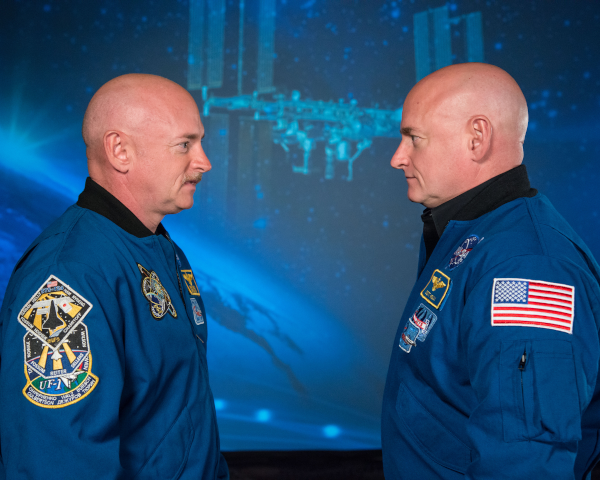
Before humans head to Mars, we want to know what challenges we will face. Long-term stays aboard the space station have allowed us to uncover and begin solving challenges that could be presented by the human body’s response to space. For example, some space station astronauts unexpectedly developed vision changes, now known as Spaceflight-Associated Neuro-Ocular Syndrome (SANS). Findings include swelling at the optic disc and flattening at the back of the eyeball. After helping discover the issue, space station research has served as a platform to better understand SANS.
NASA’s Twins Study compared astronaut Scott Kelly during his year in space with his Earth-bound twin brother Mark Kelly. It provided insights into the many ways long-term spaceflight affects a human body. Findings showed that Scott’s gene expression changed and his body reacted appropriately to vaccines while in space.
Why do this in space? The space station currently is the only place for performing research in long-duration microgravity. There is no substitute for actually sending humans into orbit where they can serve as test subjects for the science.
Why does it matter? Traveling deep into space means spending long periods of time in microgravity. To figure out how to make those trips safer and more comfortable, it is important to study humans closer to Earth in a controlled environment.
Example experiments: Fluid Shifts, Twins Study, Vision Impairment and Intracranial Pressure, Direct ICP
Links
International Space Station Research Keeps an Eye on Vision Changes in Space
NASA’s Twins Study Results Published in Science Journal
Andrew Morgan: Last Man in Fluid Shifts
NASA Investigates How Dormant Viruses Behave during Spaceflight
Back to Full List
Testing tissue chips in space
Tissue chips are roughly thumb-drive-sized devices that contain human cells in a 3D matrix, representing functions of an organ. They represent a big step in the ability of scientists to test how those cells respond to stresses, drugs, and genetic changes.
The Tissue Chips in Space initiative seeks to use these devices in microgravity to better understand and improve human health and disease treatment on Earth. Chips simulating lung, kidney, brain, and intestine behavior all have been sent to the space station by a branch of the National Institutes of Health and the ISS U.S. National Lab.
Why do this in space? Many of the changes in the human body caused by microgravity resemble the effects of diseases associated with aging on Earth, such as bone and muscle loss. In space, these changes occur much faster than they do on Earth. That means scientists may be able to use tissue chips in space to model changes that might take months or years to happen on Earth.
Why does it matter? These studies can provide insights into diseases that affect organs on Earth and in space, and potentially help inform the creation of treatments for them.
Example experiments: Gut on Chip, Organs-On-Chips as a Platform for Studying Effects of Microgravity on Human Physiology, Lung Host Defense in Microgravity, STaARS BioScience-7, Kidney Cells
Learn more:
Small Tissue Chips in Space a Big Leap Forward for Research
Houston We Have a Podcast: Organs on Chips in Space
Back to Full List
Stimulating the low-Earth orbit economy
From satellite deployment to in-space research, a vibrant commercial space economy has developed. Through the ISS U.S. National Lab, many companies are able to access the space station and conduct research and technology development investigations in microgravity. They include well-known corporations like Procter & Gamble, which has used the station to study colloids with a goal of improving products such as shampoo and fabric softener. Smaller companies like LambdaVision have leveraged the microgravity environment on the space station to improve the processes used to create retinal implants.
Supporting research activities on station is becoming a significant business too. Companies like Nanoracks and TechShot operate commercial research facilities housed on the station. A cadre of 40 companies help researchers translate their experiments into hardware small and light enough to be housed on station.
Commercial resupply contracts to bring science and supplies to the space station also have helped support the development of launch services for companies such as Northrop Grumman and SpaceX.
Why do this in space? Expanding use of the space station to commercial companies provides a new market, sparks economic development, and allows more groups to take advantage of this platform.
Why does it matter? All of these commercial activities validate business models and expand the numbers of entities with experience in conducting business in space. Commercialization of low-Earth orbit frees up resources NASA needs to continue its exploration of space. By having companies join forces with government agencies, space exploration can continue, while providing access to a platform that helps create jobs, build revenues, and create new products and services for people on Earth.
Example experiments: Advanced Colloids Experiments, Optical Fiber Production in Microgravity, Layer-by-Layer Assembly of Protein-Based Artificial Retinas in Microgravity
Learn more:
A Growing Market at Gravity’s Edge
International Space Station Research on Tiny Colloid Particles Yields Big Results
Enabling Commercial Launch Providers
NASA Moving Forward to Enable a Low-Earth Orbit Economy
NASA Report Details How Agency Significantly Benefits US Economy
Back to Full List
Growing food in microgravity
As humans explore farther from Earth, the ability to grow food is a solution to several challenges of long-duration missions. Fresh produce provides nutritious meals over multiple years and reduces cargo requirements for the trip. Many techniques for growing plants have been explored on station to prepare for these missions. On August 10, 2015, astronauts sampled their first space-grown salad. Eight types of leafy greens have been grown in the Veggie facility for astronauts to eat, fine tuning the best techniques.
Why do this in space? New solutions for watering, lighting, and growing plants have to be tested to create a food crop in microgravity. The space station has served as a platform for performing these tests, and for verifying what conditions allow the plants to grow most effectively.
Why does it matter? The packaged diet used by crews in low-Earth orbit works well, but relies on frequent resupply missions. During a mission to Mars, the vitamins and quality of packaged food would degrade over time, and couldn’t easily be restocked. Supplementation with fresh crops provides necessary nutrients while giving astronauts more variety in their diet.
Example experiments: Plant Habitat-01, Veg-01, Veg-03, Veg-04B, Advanced Astroculture
Learn more:
Veggie Plant Growth System Activated on International Space Station
Historic Veggie Moment on the Space Station
Plant Growth on the International Space Station has Global Impacts on Earth
Back to Full List
Deployment of CubeSats from station
CubeSats are one of the smallest types of satellites; they provide an inexpensive way to perform science and technology demonstrations in space. One way these compact cubes can reach Earth orbit is hitching a ride to the space station, where they are deployed from an airlock. Sharing the cost of a rocket launch with the other groups launching payloads to the space station can make deploying a CubeSat more affordable.
Some of the first CubeSats released from the station were thrown by Russian cosmonauts while they performed a spacewalk. In 2012, crew members began using the Japanese Kibo module airlock to deploy CubeSats. Soon after, American company NanoRacks started operating a more robust deployer. One of NanoRacks’ first customers, Planet, deployed CubeSats to take high resolution photos of the entire Earth each day. Planet deployed several generations of CubeSats, demonstrating the viability of their technology and business model. NASA’s CubeSat Launch initiative provides a pathway to conduct research in space for CubeSats developed by educational institutions, non-profit organizations as well as NASA Centers and programs.
Why do this in space? Putting these satellites into low-Earth orbit gives researchers and companies a unique perspective on our planet. More than 250 CubeSats have been deployed from station, performing numerous technology demonstrations, providing internet services, and more.
Why it matters? Deploying CubeSats from the space station provides a more accessible way to get new technologies to space.
Example experiments: NanoRacks-Planet Labs-Dove, AzTechSat-1, Phoenix CubeSat, NanoRacks-MinXSS
Learn more:
JEM Small Satellite Orbital Deployer
Jumpstarting the CubeSat Revolution with Reliable Launch From the ISS
Largest Flock of Earth-Imaging Satellites Launch into Orbit From Space Station
Small to Big: Enabling a Growing SmallSat Marketplace
Back to Full List
Monitoring our planet from a unique perspective
The view of Earth from the space station is life-changing for the few who get to see and photograph it in person. But this vantage point does more than create beautiful images: photos taken by astronauts can help track the evolution of our planet alongside the suite of tools inside and outside the space station. The orbiting lab has evolved into a robust platform for researchers studying Earth’s water, air, land masses, vegetation, and more. ECOSTRESS analyzes water stress in plants, while GEDI looks at the same areas of Earth, analyzing carbon stored in forests. Though the many experiments collect data individually, together they provide a set of measurements that pushes the leading edge of environmental research.
Why do this in space? At about 250 miles above Earth on a 90-minute orbit and an orbital path over 90 percent of Earth’s population, the station affords a unique perspective that cannot be obtained on the ground, and it can provide improved spatial resolution and variable lighting conditions compared to the sun-synchronous orbits of typical Earth remote-sensing satellites.
Why it matters: When scientists can better comprehend and monitor water and energy cycles, ecosystem changes, geological hazards, and population migrations, they can offer useful information regarding climate changes, as well as assist with natural disaster response.
Example experiments: Crew Earth Observations, ECOSTRESS, GEDI, OCO-3, DESIS, HISUI
Learn more:
Earth Observation From the Space Station
The Combined Power of Remote Earth Observations aboard the International Space Station
A Researcher’s Guide to: Earth Observations
Houston We Have a Podcast: The View from Above
Back to Full List
Collecting data on more than 100 billion cosmic particles
Many scientists theorize that stars, planets, and the molecules that comprise them are less than five percent of the mass-energy content of the universe. The rest is dark matter, invisible matter that cannot be detected directly but can be inferred. The Alpha Magnetic Spectrometer – 02 (AMS-02) has been looking for evidence of this substance from the space station since 2011, collecting data on more than 100 billion cosmic particles.
AMS-02 has provided researchers around the globe with data that can help determine what the universe is made of and how it began. It also has collected data on cosmic rays, how these rays travel through space, and what produces them.
Why do this in space? AMS-02’s core is a massive magnet that bends incoming charged particles. The direction they bend reveals their charge, which helps identify the type of particle. Earth’s atmosphere has a significant effect on these particles, so a space-based observatory is essential to get accurate information.
Why it matters: In addition to helping unravel scientific mysteries of the universe, AMS-02 may also allow scientists to get a more complete picture of radiation in space. It is collecting data over a complete solar cycle, which provides more information about the potential radiation exposure for astronauts headed to Mars.
Example experiments: AMS-02
Learn more:
NASA ScienceCasts: Finding the Invisible
Studying Dark Matter In Space: It Matters!
A Series of Spacewalks Four Years in the Making Will Attempt to Revive a Scientific Experiment
Back to Full List
A better understanding of pulsars and black holes
Two tools installed on the outside of the space station have worked in tandem to advance our knowledge of pulsars and black holes: NASA’s Neutron star Interior Composition Explorer (NICER) and the Monitor of All-sky X-ray Image (MAXI) from the Japan Aerospace Exploration Agency (JAXA).
In 2018, MAXI detected a new X-ray source in the sky and named it “MAXI J1820+070”. Shortly after, NICER began monitoring the source and determined it to be a black hole binary system containing a black hole with a mass several times that of our Sun.
Within days, MAXI J1820+070 became one of the brightest X-ray sources in the sky. NICER tracked the evolution of this system. Its measurements helped us understand how the inner edge of a black hole’s accretion disk (and the corona above it) change in size and shape as a black hole consumes material from a star.
Why do this in space? From above Earth, we can get a better look at the rest of the universe. Mounting multiple tools like NICER and MAXI on the same orbiting platform gives us more data on a large swath of the space around us.
Why it matters: NICER and MAXI enable new studies of neutron stars and other astrophysical sources of X-rays, advancing scientific understanding and technical development for the benefit of people on Earth.
Example experiments: NICER, MAXI
Learn more:
NASA’s NICER Catches Record-setting X-ray Burst
NASA’s NICER Mission Finds an X-ray Pulsar in a Record-fast Orbit
NASA’s NICER Mission Maps ‘Light Echoes’ of New Black Hole
Unlocking Secrets of Neutron Stars with NICER
Back to Full List
Student access to an orbiting laboratory
Numerous programs have given elementary- to college-aged students access to space and the chance to take advantage of the microgravity environment aboard the space station. More than 950,000 students have participated in the EarthKAM program, taking pictures of Earth using a station camera. HUNCH has partnered with schools around the country to send more than 1,300 student-made items to station. The Genes in Space and Guardians of the Galaxy Space Station Challenge competitions have given high school students the opportunity to design experiments flown into orbit. Millions of children have also participated in Tomatosphere™, which provides students with tomato seeds exposed to space or space-simulated environments and seeds that have not, allowing classrooms to compare how the seeds grow. In addition, students have the opportunity to talk with astronauts in space through NASA’s STEM on Station and amateur radio on the International Space Station.
Why do this in space? Increasing access to space gives students the opportunity to develop new skills, gives them space research experience, and instills an appreciation of exploration. Students also create meaningful datasets and results.
Why this matters: Providing students with access to an orbiting laboratory inspires the next generation of space researchers and explorers and creates an appreciation for science.
Example experiments: EarthKam, HUNCH, Tomatosphere, Genes in Space-3
Learn more:
A Generation Researching in Space: Twenty Years aboard the Space Station
High School Students Build Lockers for Trip to the International Space Station
Tomatosphere™: Sowing the Seeds of Discovery through Student Science
HUNCH about Student Success in Engineering?
Genes in Space-3 Successfully Identifies Unknown Microbes in Space
Students Photograph Earth from Space
Back to Full List
Capability to identify unknown microbes in space
Being able to identify microbes in space in real time – without having to send them back to Earth for identification – is revolutionary for the world of microbiology and space exploration. The Genes in Space-3 team proved this can be done when they completed the first-ever sample-to-sequence process entirely aboard the space station in 2017. Crew members collected a sample, isolated the DNA, prepped it, and then sequenced the unknown DNA. In the months leading up to this test, NASA astronaut Kate Rubins also conducted the first DNA sequencing in space.
Why do this in space? Technology and scientific tools can behave differently in microgravity than on Earth. Designing DNA and microbial sequencers for use in space and testing these devices aboard the space station is crucial to ensuring their reliability on long-duration missions.
Why it matters: A space-based DNA sequencer is an important tool to help protect astronaut health during long duration missions on the journey to Mars, aiding in the ability to diagnose and treat astronaut ailments in real time. Future explorers also could use the technology to identify DNA-based life forms beyond Earth.
Example experiments: Genes in Space-3, Biomolecular Sequencer, Genes in Space-1
Learn more:
Sequencing the Station: Investigation Aims to Identify Unknown Microbes in Space
Genes in Space-3 Successfully Identifies Unknown Microbes in Space
First DNA Sequencing in Space a Game Changer
Sequencing DNA in the Palm of Your Hand
Back to Full List
Opening up the field of colloid research
Toothpaste, 3D printing, pharmaceuticals, and detecting shifting sands on Mars may not seem related to each other at all, yet each stands to benefit from improvements made thanks to years of research on colloids aboard the space station.
Mixtures of tiny particles suspended in a liquid, colloids occur in many forms. These forms include natural mixtures such as milk and muddy water as well as a range of manufactured products from shampoo to medicine to salad dressing. Space station research has explored subjects such as stabilizing these mixtures and colloid behaviors that can be applied to products on Earth.
Why do this in space? Studying colloids on Earth is complicated by gravity, which causes some particles to rise and others to sink. Microgravity removes that complication and makes possible research that can help companies design better products.
Why it matters: This colloid research can help to improve products used in our everyday lives and create entirely new products, including some that could enable exploration farther into space. Companies such as Procter & Gamble have used station research to study how to keep a product liquid enough to dispense easily and yet prevent ingredients, or particles, from clumping together and settling.
Example experiments: ACE-H-2, ACE-T-6, ACE-T-10, BCAT, EXPPCS
Learn more:
International Space Station Research on Tiny Colloid Particles Yields Big Results
Of Strawberry Jelly and Earthquakes: Space Station Investigation Studies Colloids in Microgravity
Advanced Colloids Experiments (ACE)
Back to Full List
The evolution of fluid physics research
Fluid covers our planet, but sending fluids to space can help us better understand them. Space station fluid research began with the fundamental analysis of how fluids behave in microgravity. That research has evolved into the testing of advanced medical devices and heat transfer systems.
Rodent Research-6 tested tiny nanofluidic devices that, when implanted under the skin, could allow for the continuous delivery of drugs into a patient’s system. This process reduces the need for frequent injections or pills. A series of experiments used microgravity to study capillary forces, small forces that move a fluid along a narrow tube. Systems using capillary forces can be simpler because they rely on shapes and fluid dynamics rather than machinery to move liquid.
Why do this in space? On Earth, gravity is one of the main factors that affects how fluid flows. However, there are additional smaller forces acting on fluids. Studying fluids in space, where gravity is not a factor, helps us to better understand these small forces and use them to our advantage.
Why does it matter? An understanding of fluid physics in microgravity can influence everything from medical technologies and heat transfer systems on Earth to life support systems in space.
Example experiments: Two-Phase Flow, Capillary Flow Experiment, Capillary Structures, Rodent Research-6, Dynamic Surf
Learn more:
Fruit Punch and Foam Could Help Us Learn to Manage Liquids in Space
Implantable Device That Helped Grow Muscles of Mice in Space Could Change Lives on Earth
Space-tested Fluid Flow Concept Advances Infectious Disease Diagnoses
Back to Full List
3D printing in microgravity
The first 3D printer flew to the space station in 2014. Developed by Made in Space, the printer produced dozens of parts that researchers analyzed and compared with those made on the ground. Analysis revealed that microgravity had no significant effects on the process, demonstrating that a 3D printer works normally in space.
Later experiments tested using recycled plastic to print objects and using a specialized bioprinter to print human tissue. The BioFabrication Facility (BFF) took small steps toward printing human organs and tissues in microgravity, using ultra-fine layers of bioink.
Why do this in space? Testing printers on the station paves the way for future space missions to be more independent of Earth. Needed items could be 3D printed rather than sent from Earth and carried for the entire journey.
Why does it matter? Using recycled material for printing could make use of material that otherwise would take up limited stowage space on long-duration missions and allow it to be used for creating needed parts.
Printing human tissue is a part of a long-term plan to manufacture entire human organs in space using refined biological 3D printing techniques. This effort could help provide increased access to organs for transplants on Earth.
Example experiments: Additive Manufacturing Facility, Made in Space Recycler, 3D Printing in Zero-G, AMF-ABS Design Values, Refabricator, BioFabrication Facility
Learn more:
Solving the Challenges of Long Duration Space Flight with 3D Printing
NASA ScienceCasts: Cutting-edge Biomanufacturing Aboard the International Space Station
3-D Printer Could Turn Space Station into ‘Machine Shop’
Space Station 3-D Printer Builds Ratchet Wrench To Complete First Phase Of Operations
Back to Full List
Responding to natural disasters
With crew handheld camera imagery as a core component, the station has become an active participant in orbital data collection to support disaster response activities both within the U.S. and abroad. Astronauts snap images of disasters such as storms and fires throughout their progression, documenting cloud cover, flooding, and changes to the land. Pictures also are taken using mounted station cameras like the SS-HDTV and HDTV-EF2. SS-HDTV, developed to take night images of Earth, can be used to check if power has been restored to cities after a disaster.
The Lightning Imaging Sensor (LIS) mounted on station also detects the distribution and variability of lightning in order to improve severe weather forecasting. The ISS SERVIR Environmental Research and Visualization System (ISERV) has helped developing countries enhance their environmental decision-making processes.
Why do this in space? The space station has an inclined, low-Earth orbit that provides variable views and lighting over more than 90 percent of the inhabited surface of the Earth. This is a useful complement to sensor systems in higher-altitude polar orbits for collecting imagery. These pictures are referenced by teams on the ground.
Why does it matter? These data allow for more informed responses to disasters from a perspective you cannot get on Earth, and assists with forecasting for future storms.
Example experiments: LIS, ISERV, Uragan-GC (Hurricane-GC), Crew Earth Observations, SS-HDTV, HDTV-EF2, Uragan-Zemlya (Hurricane-Earth
Learn more
Clear High-definition Images Aid Disaster Response
Space station camera captures Earthly disaster scenes
Investigation of Earth Catastrophes From the International Space Station: Uragan Program
NASA Tracking Florence From Every Angle and Wavelength
Benefits for Humanity: After the Storm
International Space Station Imagery for Disaster Response
Back to Full List
Erin Winick
International Space Station Program Research Office


















